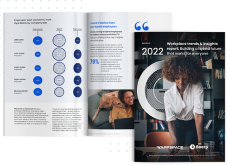
How to evolve and digitally transform the employee experience
Duncan Smith
July 10, 2019Digital transformation and positive employee experience can make or break the success of your organization.
Successful companies understand that to win in the marketplace, you must first win in the workplace. Digital workplaces help improve employee experience, offer efficient ways for internal communication, contribute to customer satisfaction and drive profits.
The challenge for business communicators and mission leaders is figuring out how to embrace the new culture of work and shift to a truly collaborative and engaging digital workplace.
Internal communications help build a strong culture and shape behaviors that support organizational changes. How do you successfully communicate the change to a global audience in this era of disruptive innovation and technology-driven growth?

Digitally transformation and employee experience
A panel discussion at the recent IABC World Conference, tackled the challenges faced and benefits gained when evolving the employee experience. Elisha McCallum, Director of Global Communications at Finning International; Dave Carley, Senior Customer Success Manager at Microsoft Canada; and Agustin Del Vento, Founder & Managing Director at Change Champions Consulting, shared their insights, and we’ve pulled together some highlights of that discussion.
Everything will be digital
Digital transformation isn’t just a buzzword – it’s the reinvention of an organization to improve performance and reshape how companies deliver value.
During this type of significant change, more than 8 out of 10 employees experience competing priorities between the old analog ways of working and the new digital forms of collaboration and communication that are introduced. When these employees struggle to find a balance, it’s imperative that communicators develop effective partnerships with senior management and IT leaders.
Dave of Microsoft Canada: “Technology is moving faster than ever before, but many of our customers haven’t adopted all the digital capabilities they own. In the past, IT would rollout technologies or upgrade systems with no recognition of the new habits that people will need to embrace. Offering generic product videos and uninspiring FYI emails is not enough. Every investment in technology should amplify the benefits for the end-user – whether through better experiences, higher product quality, or operating efficiencies. Employees need to understand how they are going to use technology to get work done.”
Key takeaway:
When it comes to digital transformation and employee experience, executive voices matter and are critical to building trust in order to demonstrate a real commitment to the digital enterprise. Make sure you have engaged and visible sponsorship from your leadership team. If executives don’t lead by example or communicate the benefits of change, business goals will not be achieved.
The landscape of work is changing
As mobile and digital technologies have risen in prominence – instant messaging, presence awareness, video chat, @mentions, likes, comments, etc. – today’s workers expect social to be a ubiquitous part of the employee experience. By 2025, millennials will form 75% of the global workforce, and their attitudes about work and knowledge of new technologies are redefining workplace culture.
Elisha of Finning International: “Employees are used to using social tools in their personal lives, so it’s not a large step for many of them to move to collaboration tools at work. Where companies can get tripped up is getting leadership to understand the value of a socialized network, because it doesn’t always jive with old school-thinking. That’s why it’s so important to have internal champions and executive sponsors — they are keys to success and critical to moving past old baggage.”
Key takeaway:
The power of social is not about the technology at all, but about empowering people to work in a way that is more natural and organic. If done correctly, a digital workplace can improve employee engagement and transparency. Ensure supportive processes, policies and community guidelines are in place to promote a growth-enabled culture.
Remote work is going global
Collaboration is evolving, moving from office-centric environments to application-centric workspaces, with an estimated 70% of people globally working away from the office at least once every week. While the world is more connected and interdependent than ever, breaking down regional and operational silos is easier said than done. Building trust and dispelling fears take time.
Organizations must think and act globally, looking beyond local boundaries for top talent, while creating a community that is welcoming and supportive of global workers. Most people want to work well together, it’s just that time-zones, cultural differences, and sometimes language barriers can get in the way.
David of Microsoft Canada: “Today, people work in twice as many teams as they did just five years ago. Teams are increasingly geographically distributed, and employees want the option to work remotely, anywhere, at any time. To do this, they need the tools and digital workspaces to communicate, access their data, and stay productive.”
Key takeaway:
As digital work increases and cross-functional teams expand across borders, the severe limitations of email and desktop apps has led to the rise of centralized cloud-based workplace conversations. Proficiency in digital tools will become a core competency for all remote workers over the next few years.
Change is never a ‘one and done’ exercise
According to a recent Gartner report, “the majority of digital workplace initiatives will fail to establish new ways of working” without a proper investment – time, money, people, processes – in change management.
This implies a shift in people’s communications habits and knowledge sharing behaviors, as cultures won’t perform well if employees can’t translate these patterns to their specific day-to-day work. Digital transformation technology and employee experience and behavior should be viewed as two sides of the same coin.
Agustin of Change Champions Consulting: “Constant change is becoming the new normal, and the role of IT is to evangelize and enable a more collaborative digital workplace. If you look at change management from a purely tech perspective, you will fail to realize the full benefit of your investment. This requires a structured and strategic approach that encourages people to adopt digital capabilities at their own comfort level. Don’t underestimate the size of the change – break down your training and communications into manageable pieces.”
Key takeaway:
Investment in a platform or a toolset is not a strategy. Shifting to a digital workplace is more than just giving employees the latest and greatest technologies. It’s about creating capabilities that drive outcomes. Identifying digital champions who are not only receptive to change but who can positively influence their colleagues will make a world of difference.
We communicate and interact with company news and information differently than we did even just a few years ago. Whether this is driven by compressed business cycles, digital disruption, generational shifts or all three––senior management, IT leaders and internal communication teams need to come together to create a truly collaborative environment that welcomes the new culture of work.
In the words of the IABC World Conference closing keynote Peter Sheahan:
“There’s never been a more important time to be in communication. It is the glue that keeps businesses authentic and relevant.”


